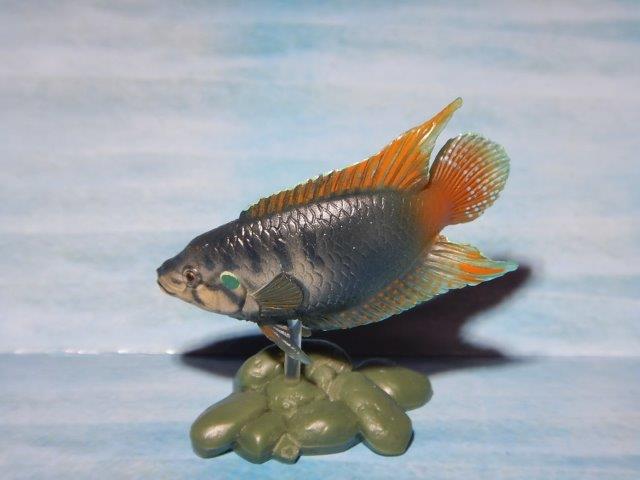
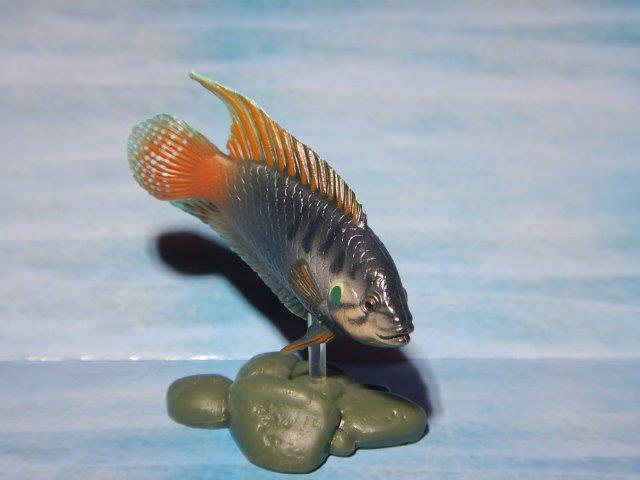
The original post: This figure is the Paradise Fish (or Paradise Gourami), Macropodus chinensis (but see note below), number 10 from the first series. This is the first and only anabantid figure in the set. The Paradise Fish is a generalist species that is found, like many of the fish in the series, in waterways throughout eastern Asia from Korea to Vietnam. Although highly adaptable and overall common in their range, they are apparently considered threatened in Thailand due to pollution (which has allowed mosquitoes and their associated diseases to increase—lousy ecological cycles); and then, in Japan, they were deliberately introduced (for pest control!) and are considered invasive. As with the few previous entries, the Paradise Fish is common in aquariums—in fact, it was one of the first ‘exotic’ aquarium fish available to the ‘western’ world. They remain popular in aquaria mainly because they are also very attractive, despite being quite aggressive. The Yujin model (and other sources) states that the normal size is around 7cm.
Editor note–this one was a source of much confusion. Names change sometimes, but Yujin made things really messy with this one.
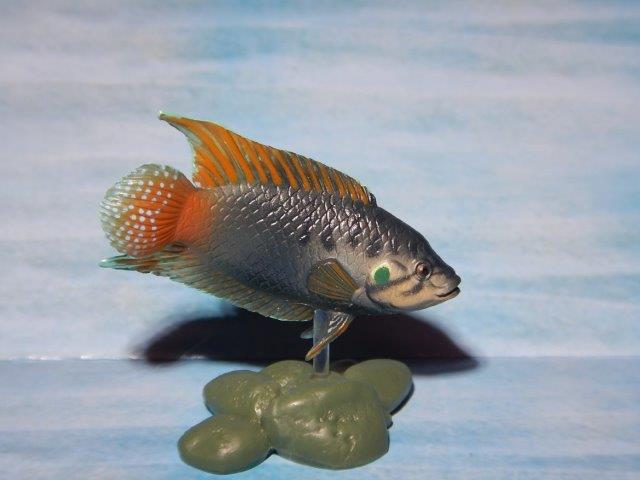

This model is about 5 cm long, making the figure roughly 1:1 (rounding—and also, most Paradise Fish do not reach 7cm). The figure is a bright, colorful one, highlighting the bright blues and reds of the species (and still not fully doing the real fish justice). The bright green cheek patch, though, is a little too exaggerated. The scales and fin rays are distinct; the pose is more of a hunting or searching pose, as the figure’s fins are fairly relaxed. The base for this one is the grey gravel. I cannot actually recall another figure of this species, but could easily be wrong—on the other hand, it is not a true Japanese fish, so those companies may be less inclined to make one; and non-Japanese companies simply don’t make enough small freshwater fish, so it’s doubtful (though I would be happy to be wrong).
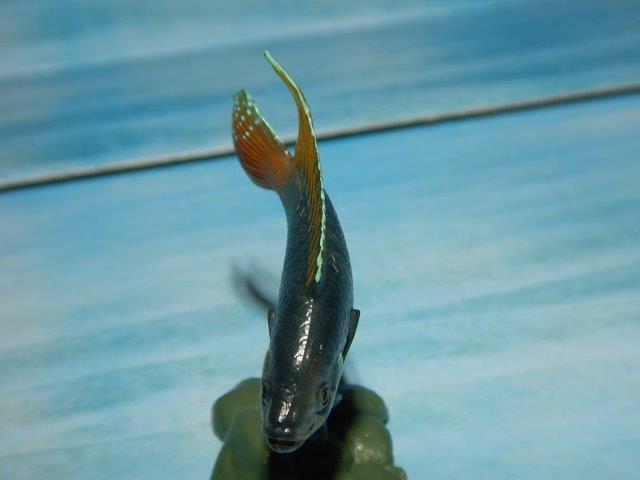
And this was a later update long after the post had been originally made:
Hey, fun update on one of the early posts–so the Paradise fish was listed by Yujin as Macropodus chinensis. It turns out that this species has been synonymized with M. ocellatus, which is known as the Round-Tail Paradise fish.
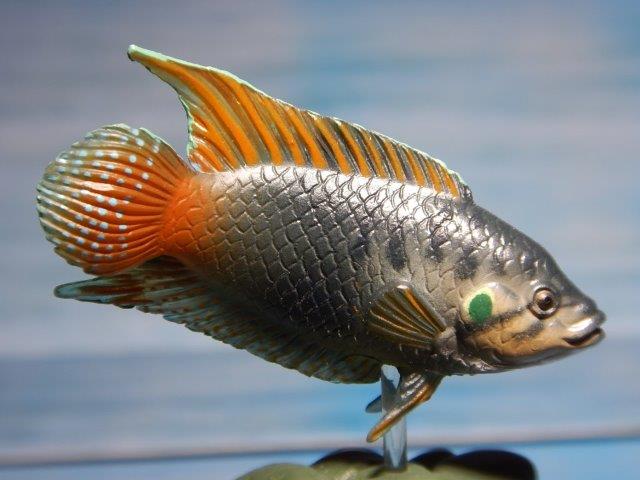
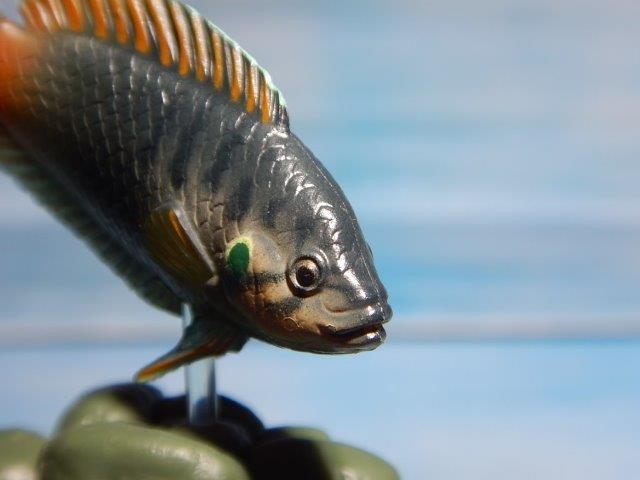
But for more fun…that was only the name given in the Book 1 reissue of the series. In the previous releases (thanks to that auction, I now know there are two others–the original first series, and the revised series) it was listed as M. opercularis, the common Paradisefish–except that the figure (from what I can tell) never had the forked tail that defines the Paradisefish, but instead always had the round tail.

To clarify, I only know that these name variances occurred because I have papers from the Series 1 original issue, and from the Series 1 re-release series. The figure from the 1st release is the figure I based my original post on, and only later received the Book 1 re-reissue (but no longer have that one). It’s surprising how much effort this one figure took to understand it! You can see the ways the papers varied here (Series 1 reissue on top):

So to update a little for the figure under it’s proper species–M. ocellatus reaches about 6.2cm, which still puts the figure at just around 1:1. The colours are more appropriate to this species, with the larger amount of blue and less pronounced striping–and obviously the rounded tail makes far more sense for this species than the ‘common’ paradise fish. The range of the round-tail paradise fish is China, Korea, and the Amur basin of Russia; the Japanese occurrences are still thought to be introductions, likely from Korea (although not sure exactly how that is known). The CITES status is not evaluated.

Starting on the 14th of January, 2024, I migrated my first Yujin Freshwater Fish Pictorial walkaround post from the Animal Toy Forum to this blog, with the intention of moving all species’/figures’ walkarounds here. The initial post contained a lengthy explanation of the series (both the original and updated) that I don’t think should be repeated each time! For those details, the post can be seen at the first post. Then we can just get to the fish. Most of the details and writing will come from the original post, although I may supplement/add where appropriate.
Disclaimer: links to Ebay and Amazon on the AnimalToyBlog are affiliate links, so we make a small commission if you use them. Thanks for supporting us!




I see you had to overcome the same nomenclatural issues I did. I think my paper also has ‘M. opercularis’ which, as you stated, has a forked tail. My guess is the original was just a typo and they corrected it for subsequent releases, even if the name they used is now a synonym.
Most likely the biggest issue is that M. opercularis is more familiar–but whoever sculpted it went their own way (both are present in Japan apparently).
The M. chinensis might have been correct at the time of printing as well; I haven’t looked too deeply, but I’m not sure when the two species were formally synonymized.